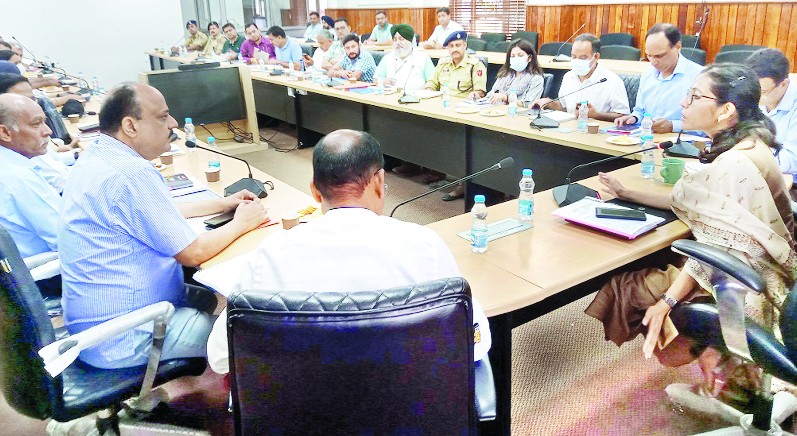As the monsoon season looms closer, concerns over potential flooding have prompted urgent and coordinated efforts across districts in Punjab. In one such vital initiative, the Deputy Commissioner (DC) of a key flood-prone district convened a comprehensive review meeting with various departments to evaluate the preparedness level and strategize a coordinated response. The meeting, held at the district administrative complex, brought together officials from the irrigation, health, power, rural development, local bodies, police, public works, revenue, and disaster management departments.
Presiding over the meeting, the DC emphasized the importance of proactive planning and efficient execution to mitigate the possible impact of floods. Stressing the unpredictability of weather patterns and the increasing frequency of extreme rainfall events, the DC urged officials to leave no stone unturned in preparing their departments and field staff to tackle emergencies.
One of the critical discussions during the session centered around the identification of flood-prone and low-lying areas within the district. Officials from the irrigation department presented updated maps and data on river water levels, embankments, and vulnerable spots. The department assured that necessary strengthening of embankments was already underway in areas previously affected by breaches, particularly along the banks of seasonal rivers and major drains.
The health department, meanwhile, was directed to ensure that all government hospitals and primary health centers were well-stocked with essential medicines, including anti-venoms, antibiotics, and oral rehydration salts. The DC reminded health officials of the increased risk of waterborne diseases during floods and asked for quick deployment plans for medical teams in case of evacuations.
In response, the civil surgeon confirmed that emergency medical response teams were being trained and would be kept on standby. Special mobile health units were also being prepared to reach remote or inaccessible areas in the event of road blockages or inundation. The department also briefed the meeting about awareness campaigns to be launched in rural areas regarding sanitation, safe drinking water, and first-aid measures.

The electricity department was tasked with conducting inspections of power lines and transformers in flood-sensitive zones. The DC expressed concern over the dangers of electrocution and short circuits during waterlogging and instructed the department to immediately de-energize affected areas if water levels rose above safe limits. Officials confirmed that mobile generators were being arranged to ensure uninterrupted power supply at relief shelters and health centers.
Officials from the Public Works Department (PWD) gave an overview of the road network, highlighting vulnerable stretches that tend to get washed away or submerged during heavy rains. The DC instructed them to complete the patchwork and repairs urgently. Coordination with the irrigation department was also discussed to ensure that culverts and drainage systems were cleaned and de-silted before the rains set in.
In a key intervention, the rural development and panchayat officials were asked to conduct gram sabha-level meetings to spread awareness about flood safety protocols and mobilize local volunteers. The DC emphasized community participation as a crucial component in disaster response and advised the panchayat secretaries to map out local evacuation routes and safe zones.
Meanwhile, the revenue department was directed to update and digitize village-wise lists of people residing in high-risk flood zones. These lists would be used not only for evacuation purposes but also to identify those eligible for post-disaster compensation and rehabilitation. The DC stressed the need for accuracy and transparency in this process to avoid discrepancies during relief distribution.
The local bodies department presented an update on de-silting operations in urban areas. Storm drains and sewerage systems in the town had already been cleaned in several phases, with municipal workers on standby for emergency duties. The department was also asked to prepare community shelters in municipal buildings and schools with adequate sanitation and hygiene facilities.
Representatives from the police and home guards briefed the meeting on their security and rescue plans. Boats and rescue equipment were already being serviced and pre-positioned in vulnerable villages. The DC advised coordination with the National Disaster Response Force (NDRF) for mock drills and training sessions for local volunteers. Police personnel would also play a key role in maintaining law and order in relief camps and during evacuations, especially in densely populated areas.
The disaster management officer presented an overview of the district’s flood control room operations. Round-the-clock helplines would be established, and a public information campaign via local radio, WhatsApp groups, and announcement vehicles would be launched to keep people informed about weather alerts, evacuation orders, and helpline numbers.
The DC further emphasized the importance of an early warning system and timely dissemination of information. He directed all departments to nominate nodal officers and maintain 24/7 contact through a dedicated WhatsApp group for flood monitoring. Daily updates on rainfall, reservoir levels, and river discharge would be shared among the departments to maintain real-time situational awareness.
In addition, the meeting reviewed the availability of food supplies and dry rations at the sub-division level. The food and civil supplies department was asked to coordinate with district warehouse managers to ensure that emergency stocks were moved closer to flood-prone areas. Relief camps would need basic amenities like rice, pulses, salt, cooking gas, clean water, and baby food.
To promote coordination at the grassroots level, sub-divisional magistrates (SDMs) were instructed to hold similar review meetings in their respective areas. They would conduct inspections of embankments, storage facilities, and shelters and report back to the district headquarters with photographs and updates.
The DC concluded the meeting with a strong message of accountability and duty. While natural calamities cannot be prevented, he said, their impact can certainly be minimized through planning, vigilance, and coordinated action. He reminded everyone that disaster management was not just about paperwork but about saving lives and livelihoods.
As the meeting adjourned, officials left with a clear mandate and timeline for their responsibilities. The district administration’s proactive steps signal a serious commitment to public safety, especially in a time when unpredictable climate events have become increasingly frequent. The collaborative atmosphere and urgency displayed by departments painted a reassuring picture of preparedness.
The spirit of inter-departmental cooperation, community involvement, and vigilant monitoring showcased in the meeting serves as a model for other districts gearing up for the monsoon season. With the right mix of planning, technology, and human response, the district hopes to meet any challenge the season may bring with resilience and resolve.


